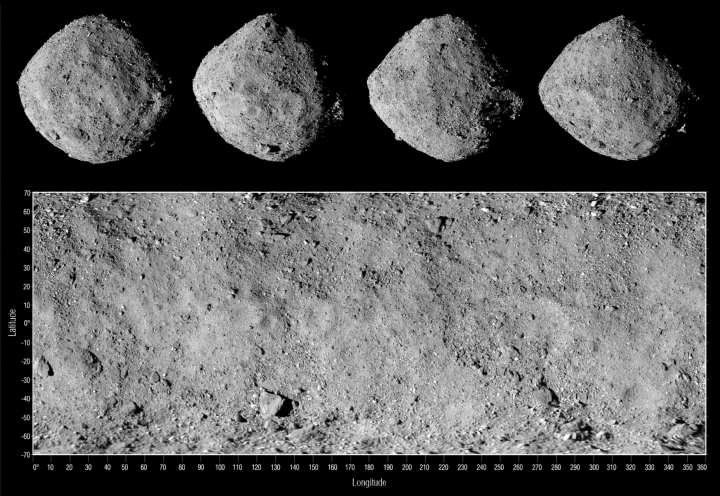Global map of Bennu

The OSIRIS-REx science team today released a global map of Bennu, compiled from images taken in December.
The map is above. It was released with no commentary. In comparing it with this global map of Ryugu, created by the Japanese probe Hayabusa-2, I am struck by how much both asteroids resemble each other.
This fact is in many ways a first. Since the first planetary probes left Earth in the 1960s the one reliable expectation that has consistently proven true is that no planetary object, be it planet, dwarf planet, moon, asteroid, or comet, was going to resemble any other planetary object. Each has been entirely unique, and unique in very startling and obvious ways.
Ryugu and Bennu represent the first planetary objects that actually look pretty much the same. Scientist will of course be able to note differences, but overall these objects clearly belong to a specific class of asteroids, which in this case is the rubble pile.
In a sense, this similarity marks a significant advancement in our knowledge. Up until now, we had observed so few objects that our knowledge base wasn’t large enough to start seeing patterns within our general classifications of planet, asteroid, or comets. That is now finally changing.
On Christmas Eve 1968 three Americans became the first humans to visit another world. What they did to celebrate was unexpected and profound, and will be remembered throughout all human history. Genesis: the Story of Apollo 8, Robert Zimmerman's classic history of humanity's first journey to another world, tells that story, and it is now available as both an ebook and an audiobook, both with a foreword by Valerie Anders and a new introduction by Robert Zimmerman.
The print edition can be purchased at Amazon or from any other book seller. If you want an autographed copy the price is $60 for the hardback and $45 for the paperback, plus $8 shipping for each. Go here for purchasing details. The ebook is available everywhere for $5.99 (before discount) at amazon, or direct from my ebook publisher, ebookit. If you buy it from ebookit you don't support the big tech companies and the author gets a bigger cut much sooner.
The audiobook is also available at all these vendors, and is also free with a 30-day trial membership to Audible.
"Not simply about one mission, [Genesis] is also the history of America's quest for the moon... Zimmerman has done a masterful job of tying disparate events together into a solid account of one of America's greatest human triumphs."--San Antonio Express-News

The OSIRIS-REx science team today released a global map of Bennu, compiled from images taken in December.
The map is above. It was released with no commentary. In comparing it with this global map of Ryugu, created by the Japanese probe Hayabusa-2, I am struck by how much both asteroids resemble each other.
This fact is in many ways a first. Since the first planetary probes left Earth in the 1960s the one reliable expectation that has consistently proven true is that no planetary object, be it planet, dwarf planet, moon, asteroid, or comet, was going to resemble any other planetary object. Each has been entirely unique, and unique in very startling and obvious ways.
Ryugu and Bennu represent the first planetary objects that actually look pretty much the same. Scientist will of course be able to note differences, but overall these objects clearly belong to a specific class of asteroids, which in this case is the rubble pile.
In a sense, this similarity marks a significant advancement in our knowledge. Up until now, we had observed so few objects that our knowledge base wasn’t large enough to start seeing patterns within our general classifications of planet, asteroid, or comets. That is now finally changing.
On Christmas Eve 1968 three Americans became the first humans to visit another world. What they did to celebrate was unexpected and profound, and will be remembered throughout all human history. Genesis: the Story of Apollo 8, Robert Zimmerman's classic history of humanity's first journey to another world, tells that story, and it is now available as both an ebook and an audiobook, both with a foreword by Valerie Anders and a new introduction by Robert Zimmerman.
The print edition can be purchased at Amazon or from any other book seller. If you want an autographed copy the price is $60 for the hardback and $45 for the paperback, plus $8 shipping for each. Go here for purchasing details. The ebook is available everywhere for $5.99 (before discount) at amazon, or direct from my ebook publisher, ebookit. If you buy it from ebookit you don't support the big tech companies and the author gets a bigger cut much sooner.
The audiobook is also available at all these vendors, and is also free with a 30-day trial membership to Audible.
"Not simply about one mission, [Genesis] is also the history of America's quest for the moon... Zimmerman has done a masterful job of tying disparate events together into a solid account of one of America's greatest human triumphs."--San Antonio Express-News


I always thought the Moon and Mercury closely resemble each other. Perhaps that resemblance is just superficial?
mpthompson: You have a point. They do resemble each other, though not as much as one might think if you limit your look to just a quick glance.
I could say that this is the exception that proves my rule. Yeah, I could say that. Yup. That’s my story and I’m sticking to it.
I’ve always viewed Uranus & Neptune as kindred.
mpthompson,
Superficially similar, but the Moon’s average density is 3.34 g/cc while that of Mercury is 5.43 g/cc – almost the same as Earth’s 5.52g/cc.